THE
HECKLER & KOCH Mk. 23 S.O.C.O.M
The
Worlds first Assault Pistol
By
Barry Johnson.
I
have sitting before me a SOCOM Mk 23 pistol and I am, quite literally stunned.
The reasons for this are many fold and will become apparent as you read this
article, but the overall effect is wow! Before it arrived I think that I had
read almost every article and book about this weapon and studied numerous
photographs, from the first prototypes right on up to the final production
pieces, but nothing, I can assure you prepares you for the real thing.
Most
of the material was from the States; magazines like Guns & Ammo and
Handgunner, etc. Make no mistake about it, these are quality journals whose
staff are some of the most respected men in the business, but I cannot help
feeling that they have missed the point somehow. You see, they all kept talking
about size, weight, width and concealability and almost all bemoaned the shear
bulk of the gun. I believe this attitude has also (to a much lesser extent)
crept into the thinking of the special forces units that the weapon was designed
for, probably because most of them read the aforementioned publications and
respect (rightly so) the opinions of the journalists (many of whom are former
soldiers and law enforcement officers). So in this article I intend to try and
redress the balance a little.
First
and foremost let me state from the beginning that I think we all got of on the
wrong foot with the SOCOM Mk 23 for a very simple reason. The handgun, be it a
semi auto or a revolver is and always was a defensive weapon. It was intended to
be used either as a back up for a larger offensive firearm or as a last ditch
moral booster. In the case of police officers, security personnel and private
citizens, as something to have if all the planning went out of the window and
one needed to defend oneself. It has to be said that as far back as the wild
west and right on up to the present day there have always been men and women who
have demonstrated some remarkable fighting skills with handguns, from the old
time gunfighters to the modern military hostage rescue and black operations
troops who employ them; but the handgun has always been designed as a weapon for
self defence.
Since
the Sixties various manufacturers and custom shops have been marketing and
selling products that they have developed to enhance off the shelf weapons to
make them more user friendly, reliable and accurate. It started with custom
safeties and extended magazine and slide releases then went onto high quality
barrels that made the guns more accurate, better and improved sights, magazines
and grips, more durable finishes and materials, and in the past fifteen years or
so torches and lasers to enable night fighting and hostage rescue. In short,
they have been subconsciously evolving the handgun into a primary offensive
weapon so that it can be used in tight, confined spaces like bunkers,
aeroplanes, lift shafts and from the inside of vehicles with maximum effect. All
the designers at Heckler & Koch have done (at the behest of the US Special
Operations Command) is look at what they required and at what was currently
being offered by a multitude of sources and combine the requirements and current
thinking into a state of the art weapon, thereby introducing the worlds first
out of the box assault pistol, the H&K Mk 23 SOCOM, or to give it its
official title, The Offensive Handgun Model 0. In other words a weapon that is
designed from scratch to initiate an action and then to finish it, whilst
keeping its user alive and from harms way.
Well
thatís enough of a history lesson, lets take a look at the gun itself and
address some of the remarks already made about it.
On
opening the stout cardboard box you are greeted by the sight of the pistol
itself, one spare magazine, a bilingual operators manual in English and German,
two spare Ď0í rings and a factory test target. This target was shot at
twenty five meters at the factory from a rest. The five shot group measures one
and a half inches across, with four of the rounds in one ragged hole ĺ of an inch across!.
To
be fair the first impression most people have is the weapons size, which one
cannot deny, is large. It has been compared to a Desert Eagle and it has to be
said that the two guns dimensions are roughly equal, but there the similarity
ends. A lot has been written about this, mostly bemoaning the fact that a Desert
Eagle has double the range, and in 44 Magnum two and a half times the muzzle
energy of the SOCOM, but the former was never intended as a serious combat
handgun, more as an interesting sporting weapon for those turned on by the idea
of a semi automatic magnum. Furthermore the Desert Eagle has nowhere near the
service life or the reliability of the Mk. 23 and is quite a bit heavier, so
more unwieldy.
Anyway,
size is a comparative in the world of handguns, for example a four inch barreled
Ruger Security Six .357
Magnum is only five millimeters shorter than the SOCOM and is slightly wider
at the cylinder. It also sits much higher in the hand and felt recoil is
substantially worse, yet it is still carried and used by a number of
professionals in the world today. Again on the subject of width the Sig P226
series of weapons is only three point eight millimeters narrower than the SOCOM
but is one of the most popular concealed carry guns in use on the planet (The
P228 being my personal favourite);
users including the FBI, the SAS and the covert arms of British Intelligence.
As
any plain clothes operator will explain, all the mid size weapons like the
Browning High Power or the Colt M1911 A1 are, at best, only casually
concealable. They are fine if you want to stroll down the street or stand and
pretend to read your paper on the corner without attracting attention to the
fact that you are carrying a firearm, but woe betide you if you decide to go and
sit on a bar stool in a dodgy pub or go for a dance at the local IRA disco. For
this sort of thing you have to go to something like the PPK in an ankle holster.
In short the SOCOM was never intended as a concealed carry weapon, but was
designed from the outset to be worn in a military type holster either on the
hip, leg or as part of some ballistic armour setup. Though for those of you who
are six feet six and getting on for twenty stone of pure muscle I have been
reliably informed (by dwsuk!) that the Uncle Mikes shoulder holster designed for
the Desert Eagle will fit it just fine.
On
lifting the gun from its box I was pleasantly surprised by its weight. Could
this be the cumbersome, ungainly thing of which I had read? A quick look at some
reference material told me that fully loaded with a twelve round magazine, the
MK. 23 was only three hundred and fifty grams heavier than an unloaded M1911 A1.
Now I donít know about you but considering what the SOCOM is capable of, I
would consider that an excellent deal in anyoneís language. By the way three
hundred and fifty grams is about the same weight as two loaded Colt 45 magazines, in other words, negligible. Also one has to consider
that the sort of people that will be using the SOCOM pistol are the kind that
are quite capable of doing a hundred press ups without breaking into a sweat and
on average can cover thirty to forty miles a day on foot over some very nasty
terrain and then pull your arms off for fun.
As
to the weapon being cumbersome I find this to be absolute rubbish. Yes the size
does take a little getting used to if you are used to GP35ís or Glocks, but
once you get used to it handles like a dream. Unloaded the weapon does seem a
bit top heavy but that is because of the polymer frame which is very light, but
when one inserts a loaded magazine the balance is perfect. The grip angle helps
also, being seventeen degrees, the same as the Colt M1911 A1. I find that it
naturally points to the target from the draw and that the sights line up without
a second thought. The gun can be grasped in any of the standard shooting
stances, can be maneuvered in tight spaces just like any other pistol and can be
fired one handed if necessary without difficulty, so no problems there.
So
what is so good about the SOCOM after all this alleged moaning?
Well,
first of all is build quality As soon as you handle the SOCOM and start to field
strip it you will soon begin to realise why Heckler & Koch are amongst the
world leaders in the field of combat small arms. The slide is made from
molysteel and milled using the latest CNC technology to very exacting
tolerances, with no tool marks or blemishes whatsoever. The Maritime finish that
is used on the slide, barrel, magazine and some internal parts of the pistol has
a toughness unlike any that I have ever seen on a military weapon. It is
impervious to the effects of the elements and can survive prolonged immersion in
salt water. German combat divers have had the Mk 23 for a number of years now
and the guns show no kind of wear to the Maritime finish, which by the way is a
closely guarded secret at H&K.
Looking
at the slide you will notice the thickness of the slide walls and the overall no
nonsense stout construction. This in no small way helps contribute to the
SOCOMís long service life. For example the standard service life of a Beretta
92F before depot maintenance is five thousand rounds of Nato 9mm, and for the
.45 M1911 A1 the number is fifteen thousand rounds of 230 grain Ball before it
needs a visit to the armourer. The Mk 23 on the other hand is recommended for
depot inspection only every thirty thousand rounds, and that is with +P 180
grain Teflon bullets! Next up is the barrel, which again is of molysteel and CNC
machined. The muzzle end is threaded for a suppressor and about an inch from the
bore is the infamous ĎOí ring. This looks like a flimsy bit of green rubber
that just happens to be hanging around, but it is in fact one of the main
features of the SOCOM. It is made from something extremely tough called
Elastometer and with routine maintenance has a service life of twenty four
thousand rounds, but just in case the gun comes with two spare anyway. What the
ĎOí ring does is form a seal between the barrel and the barrel bushing of
the slide and this, coupled with the exact fit of the breach block and ejection
port go a long way to contributing to the pistols excellent accuracy. Another
function of the ĎOí ring is to stop the suppressor from jiggling around on
the end of the gun, which Iíve experienced on other suppressed pistols with a
browning type lockup, and which can be very off-putting when bringing the weapon
to bear on a target, and can also halve the life of the weapon in question.
The
bore of the SOCOM has polygonal rifling which makes it more accurate because a
better gas seal is achieved between the jacket of the round and the internal
surface of the bore, it also makes it a lot easier to clean. Teflon rounds will
have no adverse effects on the bore if routine maintenance is carried out.
Now
we come to the recoil spring/buffer assembly which is not dissimilar to the ones
you can find on the USP. It sounds more complicated than it actually is, for as
far as the operator is concerned it is just a one piece assembly that simply
lifts on or off the weapon for cleaning purposes. But this does not do the thing
justice because this very simple component helps give the Mk 23 its long service
life and makes felt recoil a little more friendly with standard ammo and a lot
more friendly with the +P Teflon rounds, with up to a thirty percent decrease in
felt recoil by the user.
Last,
but by no means least comes the frame assembly. This is constructed of something
called injection moulded glass fibre reinforced poly(a)mide, but not having a
degree in chemistry, or in fact an anything in chemistry, I prefer to call it
polymer (and even then Iím showing off). Basically it is light as a feather
and at least as tough as most steels around, you could probably run it over in a
tank with no adverse effects. This has metal inserts moulded into the top
portion of the frame in two places, at the rear of the frame for the rear slide
rails and at the mid way section to form the locking block/recoil spring housing
and slide rails. The grip area of the frame is a one piece moulding that has
pebbled side panels and chequered front and rear strap that give a firm slip
free grip that works well with sweaty or wet hands. The only other bit of metal
on the frame is the serial number plate which is finished in the white and can
be found in the same place as on the Glock pistols.
The
working parts of the frame come in two groups; internal and external. The
internal working parts are manufactured from stainless steel and again show no
tool marks or sloppy fitting and obviously have been built chunky to last a
lifetime. The external frame parts are made from the usual high grade molysteels
and finished using some form of chemical coating that, I must say, is not as
durable as that of the rest of the gun. I have no idea why the designers at
H&K chose to do this instead of using the excellent Maritime finish, as on
the rest of the pistol. Iím sure there is a reason, but maybe not a good one.
A better touch is the hammer, whose cocking spur is covered in hardish rubber,
which makes for a very positive manual cock with slippery hands and would, I
imagine help if you were stupid enough to drop the thing onto a hard surface.
Well,
thatís the Socom in pieces, what is it like all put together?
As
stated before it is big. So what? The Mk 23 is intended for specialist Green
work, it is not intended to be slipped inside James Bonds dinner jacket or be
pulled out of a ladies garter. Despite its size I think it handles very well and
is no more difficult to master than any other gun doing the rounds at the
moment.
The
controls are conventional enough and very easy to master with the slide release
and ambidextrous safety where you
would expect to find them. In front of the safety catch on the left side of
the frame you will find the decocking lever and at the rear of the flared
trigger guard are the ambidextrous mag releases that need to be pushed down to
release the magazine. But, and this is
a big But. Why donít the engineers at H&K please go and measure an average
human beings thumb? I must admit that I have visions of them taking the
measurements of an Orangutan by mistake at Hamburg zoo and then going back to
the factory and inventing the magazine release for the USPís and SOCOMís. I
have larger than average hands, but try as I might I cannot press the mag
release of the SOCOM with the thumb of my firing hand without radically shifting
the gun in my grip. Instead I use the middle finger of my firing hand to dump
the magazine using the mag release on the other side of the weapon. With
practice this is fast, but I would still prefer a Colt/Browning type mag
release. While I am on the subject they could also make the selector levers on
the MP5ís a bit longer too, especially on the old SEF trigger groups.
The
trigger guard on the SOCOM is rather large and deep for a pistol, but is
designed that way so as to allow the use of Arctic or abseiling gloves and dry
suits by the operators. The strange flares at the rear of the guard, just in
front of the mag releases are protective ears that are there to prevent the
accidental dumping of the magazine. The double action trigger pull is a little
heavy for a handgun, but again in sub zero temperatures or after prolonged
exposure in the sea the hands are going to be less dexterous than usual, so it
makes sense to have a heavier double action pull. However at nearly thirteen
pounds it is by no means insurmountable and the action is very smooth with no
creep or stacking. The single action breaks at nearly five pounds and is smooth
and crisp enough to let you get headshots at fifty meters with ease. The sights
on the gun are excellent, the long slide allowing for a longer than usual sight
radius that obviously helps with the accuracy. Both the fore and rear sights
ride high on the slide, this is so that it is still possible to get a good sight
picture when using the suppressor. Tritium inserts are available to replace the
bright white plastic ones supplied with the SOCOM, but I find these work fine in
most conditions except in near total darkness.
The
magazine is very sturdy and is finished in the same Maritime coating as the
slide and barrel. It is designed to carry twelve rounds of ammo and works very
reliably with that amount, so there is no need to only load ten as a precaution
against jamming because it is not going to happen. When the mag release is
pressed the magazine jumps clear of the weapon very positively for a quick
reload. By the way .45 calibre USP
magazines will not fit the Mk 23 pistol, in fact not one of the USPís
components will interchange with the SOCOM, including the torch mount, so
donít even try. There are a number of torch/laser mounts now on offer for the
SOCOM, from the simple, but superb Surefire 3-6 volt torch mounts right on up to
the Wilcox Industries LAM (laser aiming module). The latter has now been
standardised as the module for USSOCOM and incorporates a high power torch, a
red dot laser and an invisible spectrum laser for use with infrared night vision
devices.
There
are currently two types of sound suppressor for the SOCOM. One is made by the
Swiss firm of Brugger & Thomet (who are now contracted to make all of H&Kís
sound suppressing equipment) and the other is manufactured by Knights Armament
of California. Of the two the Knights is said to be quieter, giving a sound
reduction of twenty six decibels dry and thirty four wet (after having been
immersed in fluid), while the Swiss unit gives a reduction in sound of eighteen
decibels dry and twenty eight wet. However, it must be said that environmental
conditions such as temperature, altitude and humidity can affect any suppressors
performance so the information above can only be taken as a guide. The two units
both weigh just under three hundred grams and are both a little short of eight
inches long, though they are quite dissimilar in appearance. The US military has
taken on board the Knights unit, while outside of the USA the Swiss unit seems
to be easier to get hold of (Knights will not export from the USA Ė dwsuk).
One interesting thing about the Brugger & Thomet unit is the fact that the
recoil booster on the suppressor can be fine tuned to a specific gun so that it
can affect accuracy and also shift the point of impact, though, of course if put
on a different weapon it will have to be re-calibrated. The American unit does
not have this capability but is said to enhance accuracy anyway.
Well
thatís it. To sum up the H&K Mk 23 pistol is the most reliable, most
accurate combat pistol in use anywhere in the world today. Period. Nothing can
touch it as far as strength, dependability and accuracy are concerned. It is
also a .45 ACP that is cleared to consume a steady diet of +P Teflon tipped ammo
that will penetrate Kevlar and other types of ballistic nylon, at ninety degree
angles the Teflon round could go through up to half an inch of rolled armour
plate. It has a magazine capacity of twelve rounds, plus one up the spout and
comes with a spare magazine as standard. It is designed to take accessories such
as a laser, a torch and suppressor to enhance its mission capabilities and
range, and in the hands of a professional special forces soldier is probably the
most deadly, most advanced combat handgun on the planet. Oh, and I nearly
forgotÖÖ.it is quite big.
NOTE from dwsuk: If you want a SOCOM they are available but are VERY expensive at about £1800. Try Conjay Arms.
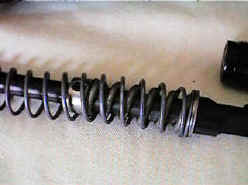 |
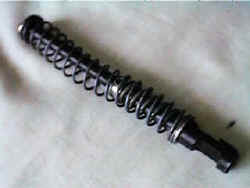 |
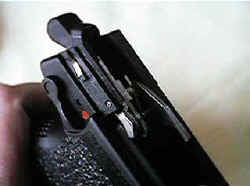 |
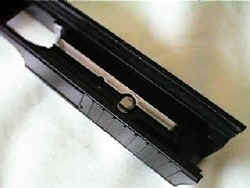 |
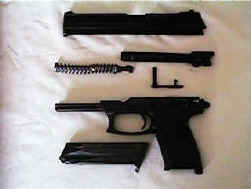 |
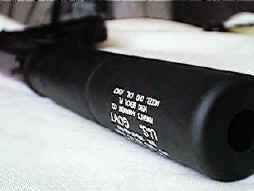 |
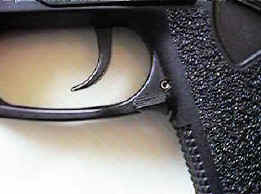 |
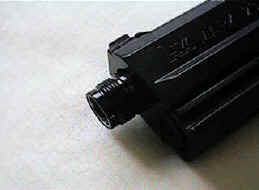 |
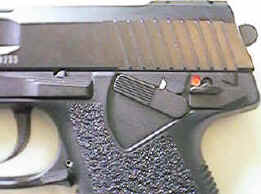 |
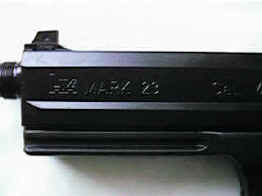 |
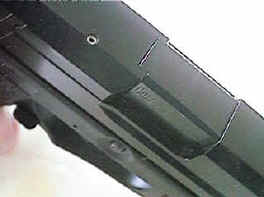 |
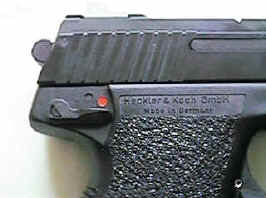 |